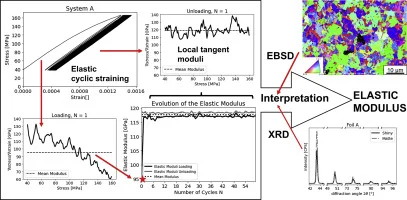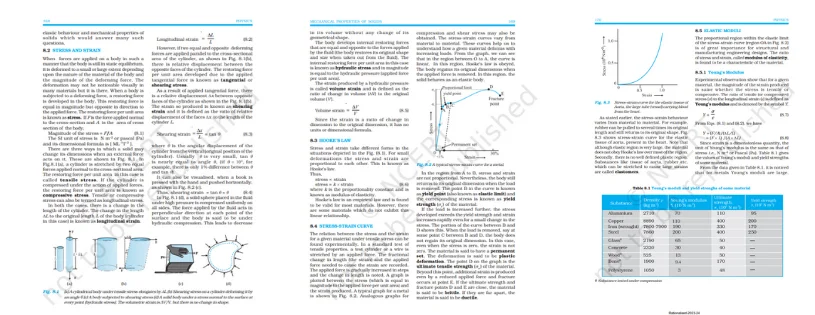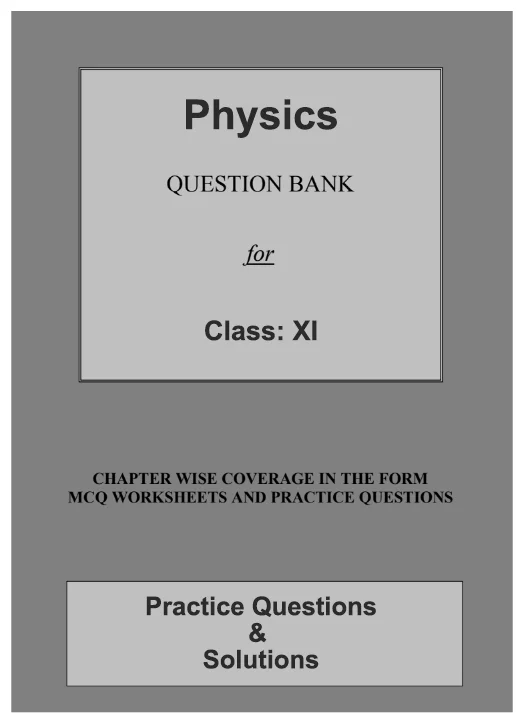Elastic moduli, a fundamental concept in materials science and physics, characterize a material's response to deformation. Comprising Young's Modulus, Shear Modulus, and Bulk Modulus, these properties quantify a material's ability to withstand or undergo strain under external forces. Young's Modulus measures the extension or compression along an applied force, Shear Modulus assesses deformation by parallel forces, and Bulk Modulus gauges volumetric changes under pressure. Understanding elastic moduli is pivotal in designing structures, predicting material behavior, and optimizing manufacturing processes. This blog will delve into the intricacies of each modulus, exploring their significance in various industries and applications.

A Deep Dive into Elastic Moduli in Materials Science and Engineering
Young’s Modulus of Elasticity :
Young's Modulus of Elasticity, often denoted by E, is a material property that describes the stiffness or rigidity of a material in response to applied stress. It is named after the 18th-century scientist Thomas Young. Young's Modulus is defined as the ratio of stress (σ) to strain (ε) within the elastic limit of a material. Mathematically, it is expressed as:
E=εσ
Where:
- E is Young's Modulus (in Pascals or N/m²).
- σ is the stress applied to the material (in Pascals or N/m²).
- ε is the resulting strain (dimensionless).
Key points about Young's Modulus:
1. Units: Young's Modulus is measured in Pascals (Pa) or N/m² in the International System of Units (SI). In some cases, it may be expressed in gigapascals (GPa) for convenience.
2. Stiffness: A higher Young's Modulus indicates a stiffer material, meaning it requires more stress to induce a given amount of strain.
3. Material Dependence: Young's Modulus is specific to each material and can vary widely. For example, metals generally have higher Young's Moduli compared to polymers.
4. Elastic Limit: Young's Modulus is valid only within the elastic limit of a material, where the deformation is reversible, and the material returns to its original shape after the stress is removed.
5. Measurement: Young's Modulus is often determined experimentally through methods like tensile testing, where stress and strain are measured as a material undergoes controlled deformation.
6. Application: It is a critical parameter in engineering design, helping engineers select materials suitable for specific applications based on their stiffness requirements.
Bulk Modulus of Elasticity:
The Bulk Modulus of Elasticity, often referred to as the bulk modulus, is a material property that describes how a material's volume changes in response to changes in pressure. It is denoted by the symbol K and is defined as the ratio of the change in pressure (ΔP) to the fractional change in volume (VΔV). Mathematically, it can be expressed as:
K=−VΔVΔP
Where:
- K is the Bulk Modulus (in Pascals or N/m²).
- ΔP is the change in pressure (in Pascals or N/m²).
- VΔV is the fractional change in volume (dimensionless).
Key points about the Bulk Modulus:
1. Units: The Bulk Modulus is measured in Pascals (Pa) or N/m² in the International System of Units (SI).
2. Negative Sign: The negative sign is used because an increase in pressure usually results in a decrease in volume, and vice versa. This ensures that the Bulk Modulus is always a positive value.
3. Stiffness to Volume Changes: A higher Bulk Modulus indicates that a material is less compressible and more resistant to changes in volume under applied pressure.
4. Material Dependence: The Bulk Modulus is specific to each material and depends on factors such as its composition and structure.
5. Applications: The Bulk Modulus is particularly relevant in fluid dynamics, acoustics, and the study of materials subjected to pressure changes, such as liquids and gases.
6. Relationship to Young's Modulus: In some materials, there is a relationship between the Bulk Modulus (K) and Young's Modulus (E) given by 3(1−2)K=3(1−2σ)E, where σ is Poisson's ratio.
Elastic Moduli – Sample Problems:
let's work through a couple of sample problems involving elastic moduli, specifically Young's Modulus (E) and the Bulk Modulus (K).
Problem 1: Young's Modulus Calculation
Given:
- Stress (σ): 150 MPa
- Strain (ε): 0.002
To Find: Young's Modulus (E)
Solution: E=εσ
=150 MPa0.002E=0.002150MPa
=75,000 MPaE=75,000MPa
Answer: Young's Modulus =75,000 MPaE=75,000MPa
Problem 2: Bulk Modulus Calculation
Given:
- Change in pressure (ΔP): 2.5 GPa
- Fractional change in volume (VΔV): 2×10−42×10−4
To Find: Bulk Modulus (K)
Solution: K=−VΔVΔP
=−2.5 GPa2×10−4K=−2×10−42.5GPa
=−12.5×1010 PaK=−12.5×1010Pa
Answer: Bulk Modulus =−12.5×1010 PaK=−12.5×1010Pa

CBSE Class 11th Downloadable Resources:
| 1. CBSE Class 11th Topic Wise Summary | View Page / Download |
| 2. CBSE Class 11th NCERT Books | View Page / Download |
| 3. CBSE Class 11th NCERT Solutions | View Page / Download |
| 4. CBSE Class 11th Exemplar | View Page / Download |
| 5. CBSE Class 11th Previous Year Papers | View Page / Download |
| 6. CBSE Class 11th Sample Papers | View Page / Download |
| 7. CBSE Class 11th Question Bank | View Page / Download |
| 8. CBSE Class 11th Topic Wise Revision Notes | View Page / Download |
| 9. CBSE Class 11th Last Minutes Preparation Resources | View Page / Download |
| 10. CBSE Class 11th Best Reference Books | View Page / Download |
| 11. CBSE Class 11th Formula Booklet | View Page / Download |
Being in CBSE class 11th and considering the board examinations, you must need resources to excel. At TestprepKart we take great pride in providing CBSE class 11th all study resources in downloadable form for you to keep you going.
Below is the list of all CBSE class 11th Downloads available on TestprepKart for both Indian and NRI students preparing for CBSE class 11th in UAE, Oman, Qatar, Kuwait & Bahrain.
SAMPLE PRACTICE QUESTIONS OF SIGNIFICANT FIGURES :
Q1. What is the significance of Elastic Moduli in materials science?
Answer: Elastic Moduli are fundamental parameters that describe how materials respond to deformation under different types of stress. They play a crucial role in understanding and predicting the mechanical behavior of materials.
Q2. What are the three main types of Elastic Moduli?
Answer: The three primary types of Elastic Moduli are Young's Modulus, Shear Modulus, and Bulk Modulus. They respectively characterize a material's response to axial deformation, shear deformation, and volumetric changes.
Q3. How does Elastic Moduli differ from each other?
Answer: Young's Modulus deals with axial deformation, Shear Modulus addresses shear deformation, and Bulk Modulus pertains to volumetric changes. Each modulus provides unique insights into a material's mechanical properties.
Q4. Can materials exhibit different values for each Elastic Modulus?
Answer: Yes, materials can have distinct values for Young's Modulus, Shear Modulus, and Bulk Modulus. These values depend on the material's composition, structure, and the type of deformation it undergoes.
Q5. How are Elastic Moduli measured experimentally?
Answer: Experimental techniques involve subjecting a material to controlled stress and measuring the resulting strain. The ratio of stress to strain provides the value of the respective Elastic Modulus.

| Class 11th CBSE Physics Chapters |
| Chapter1: UNITS AND MEASUREMENTS |
| Chapter2: MOTION IN A STRAIGHT LINE |
| Chapter3: MOTION IN A PLANE |
| Chapter4: LAWS OF MOTION |
| Chapter5: WORK, ENERGY AND POWER |
| Chapter6: SYSTEM OF PARTICLES AND ROTATIONAL MOTION |
| Chapter7: GRAVITATION |
| Chapter8: MECHANICAL PROPERTIES OF SOLIDS |
| Chapter9: MECHANICAL PROPERTIES OF FLUIDS |
| Chapter10: THERMAL PROPERTIES OF MATTER |
| Chapter12: KINETIC THEORY |
| Chapter13: OSCILLATIONS |
| Chapter14: WAVES |
| Class 11th CBSE Chemistry Chapters |
| Chapter1: SOME BASIC CONCEPTS OF CHEMISTRY |
| Chapter2: STRUCTURE OF ATOMS |
| Chapter3: CLASSIFICATION OF ELEMENTS AND PERIODICITY IN PROPERTIES |
| Chapter4: CHEMICAL BONDING AND MOLECULAR STRUCTURE |
| Chapter5: THERMODYNAMICS |
| Chapter6: EQUILIBRIUM |
| Chapter7: REDOX REACTIONS |
| Chapter8: ORGANIC CHEMISTRY – SOME BASIC PRINCIPLE AND TECHNIQUES |
| Chapter9: Hydrocarbons HYDROCARBONS |
| Class 11th CBSE Mathematics chapter |
| Chapter1: SETS |
| Chapter2: RELATIONS AND FUNCTIONS |
| Chapter3: TRIGONOMETRIC FUNCTIONS |
| Chapter4: COMPLEX NUMBER AND QUADRATIC EQUATIONS |
| Chapter5: LINEAR INEQUALITIES |
| Chapter6: PERMUTATIONS AND COMBINATIONS |
| Chapter7: BINOMIAL THEOREM |
| Chapter8: SEQUENCES AND SERIES |
| Chapter9: STRAIGHT LINES |
| Chapter10: CONIC SECTIONS |
| Chapter11: INTRODUCTION TO THREE-DIMENSIONAL GEOMETRY |
| Chapter12: LIMITS AND DERIVATIVES |
| Chapter13: STATISTICS |
| Chapter14: PROBABILITY |
| Class 8 Link soon |
| Class 9 Link soon |
| Class 10 Link soon |
| Class 12 Link soon |
Leave a Reply